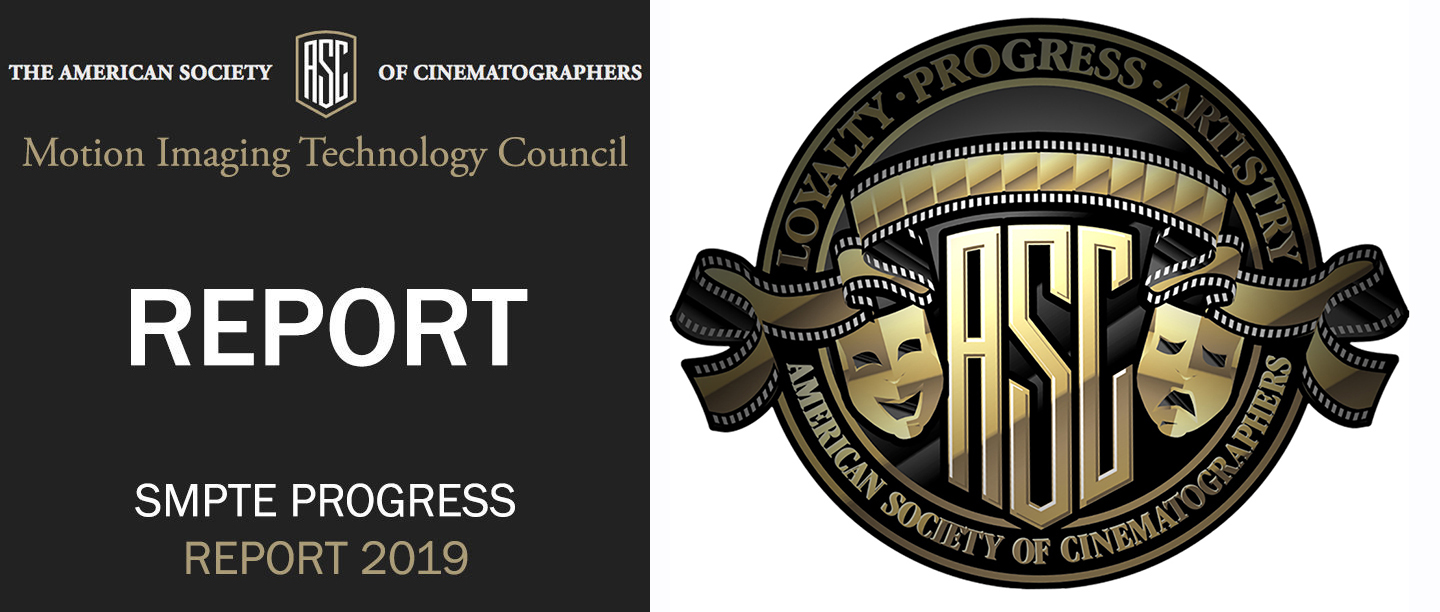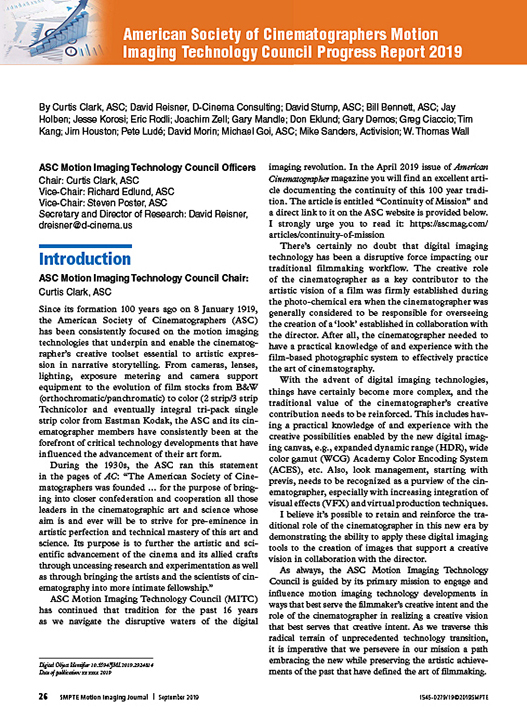
ASC MITC Committee Releases 2019 Technology Report
Recently published in the SMPTE Motion Imaging Journal, this informative 26-page document on the state of the industry’s technological gains is now also available here.

The 26-page American Society of Cinematographers Motion Imaging Technology Council Progress Report for 2019 was published in the September issue the SMPTE Motion Imaging Journal and is now also available here.
Notes MITC chair Curtis Clark, ASC in his introductory comments to the document, “Since its formation 100 years ago on 8 January 1919, the American Society of Cinematographers (ASC) has been consistently focused on the motion imaging technologies that underpin and enable the cinematographer’s creative toolset essential to artistic expression in narrative storytelling. From cameras, lenses, lighting, exposure metering and camera support equipment to the evolution of film stocks from B&W (orthochromatic/panchromatic) to color (2-strip/3-strip Technicolor and eventually integral tri-pack single strip color from Eastman Kodak, the ASC and its cinematographer members have consistently been at the forefront of critical technology developments that have influenced the advancement of their art form.

“During the 1930s, the ASC ran this statement in the pages of AC: “The American Society of Cinematographers was founded … for the purpose of bringing into closer confederation and cooperation all those leaders in the cinematographic art and science whose aim is and ever will be to strive for pre-eminence in artistic perfection and technical mastery of this art and science. Its purpose is to further the artistic and scientific advancement of the cinema and its allied crafts through unceasing research and experimentation as well as through bringing the artists and the scientists of cinematography into more intimate fellowship.”
“ASC Motion Imaging Technology Council (MITC) has continued that tradition for the past 16 years as we navigate the disruptive waters of the digital imaging revolution. In the April 2019 issue of American Cinematographer magazine you will find an excellent article documenting the continuity of this 100-year tradition. The article is entitled “Continuity of Mission” and I strongly urge you to read it.
“There’s certainly no doubt that digital imaging technology has been a disruptive force impacting our traditional filmmaking workflow. The creative role of the cinematographer as a key contributor to the artistic vision of a film was firmly established during the photochemical era when the cinematographer was generally considered to be responsible for overseeing the creation of a ‘look’ established in collaboration with the director. After all, the cinematographer needed to have a practical knowledge of and experience with the film-based photographic system to effectively practice the art of cinematography.
“With the advent of digital imaging technologies, things have certainly become more complex, and the traditional value of the cinematographer’s creative contribution needs to be reinforced. This includes having a practical knowledge of and experience with the creative possibilities enabled by the new digital imaging canvas, e.g., expanded dynamic range (HDR), wide color gamut (WCG) Academy Color Encoding System (ACES), etc. Also, look management, starting with previs, needs to be recognized as a purview of the cinematographer, especially with increasing integration of visual effects (VFX) and virtual production techniques.
I believe it’s possible to retain and reinforce the traditional role of the cinematographer in this new era by demonstrating the ability to apply these digital imaging tools to the creation of images that support a creative vision in collaboration with the director.
“As always, the ASC Motion Imaging Technology Council is guided by its primary mission to engage and influence motion imaging technology developments in ways that best serve the filmmaker’s creative intent and the role of the cinematographer in realizing a creative vision that best serves that creative intent. As we traverse this radical terrain of unprecedented technology transition, it is imperative that we persevere in our mission a path embracing the new while preserving the artistic achievements of the past that have defined the art of filmmaking.
“Building on our 2018 Progress Report, our 2019 Progress Report incorporates the most recent work being done by our committees, subcommittees, and working groups.
I would very much like to thank all those who generously devote their time and expertise to support the mission of the ASC Motion Imaging Technology Council.”
Notes MITC Secretary and Director of Research: David Reisner, “In a significant event for our Council: The Academy of Motion Picture Arts and Sciences gave the ASC Motion Imaging Technology Council’s founder and chair, Curtis Clark, the John A. Bonner Award “in recognition of his extraordinary service to the motion picture industry.” Clark has led the ASC Motion Imaging Technology Council (formerly the ASC Technology Committee) thru its 16 years of guiding the motion picture industry into the digital production era.” You can read a full story on this here.
The 2019 MITC report was authored by Clark; David Reisner, D-Cinema Consulting; David Stump, ASC; Bill Bennett, ASC; Jay Holben; Jesse Korosi; Eric Rodli; Joachim Zell; Gary Mandle; Don Eklund; Gary Demos; Greg Ciaccio; Tim Kang; Jim Houston; Pete Ludé; David Morin; Michael Goi, ASC; Mike Sanders, Activision and W. Thomas Wall.
You can access all MITC annual reports since 2007 right here.






